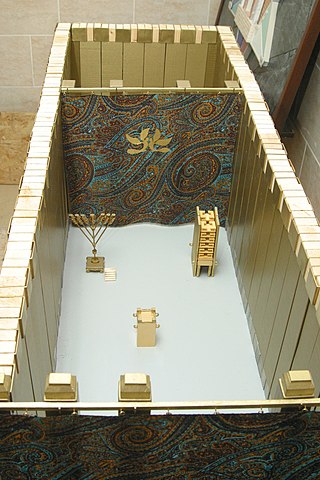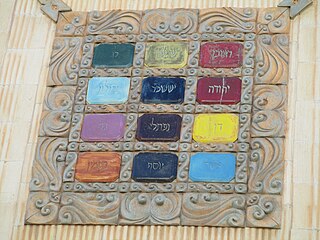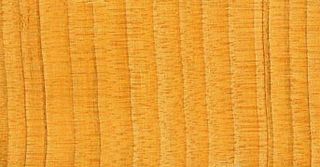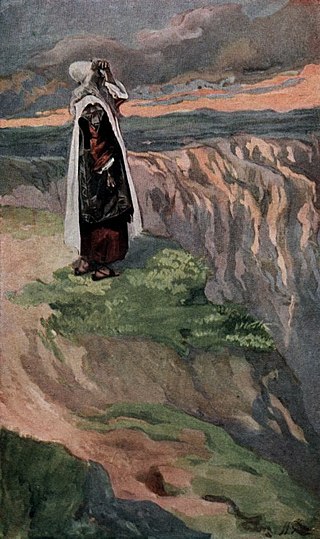
Solomon, also called Jedidiah, was the fourth monarch of the Kingdom of Israel and Judah, according to the Hebrew Bible and the Old Testament. The successor of his father David, he is described as having been the penultimate ruler of all Twelve Tribes of Israel under an amalgamated Israel and Judah. The hypothesized dates of Solomon's reign are from 970 to 931 BCE. According to the biblical narrative, after Solomon's death, his son and successor Rehoboam adopted harsh policies towards the northern Israelites, who then rejected the reign of the House of David and sought Jeroboam as their king. In the aftermath of Jeroboam's Revolt, the Israelites were split between the Kingdom of Israel in the north (Samaria) and the Kingdom of Judah in the south (Judea); the Bible depicts Rehoboam and the rest of Solomon's patrilineal descendants ruling over independent Judah alone.

The Talmud is, after the Hebrew Bible, the central text of Rabbinic Judaism and the primary source of Jewish religious law (halakha) and Jewish theology. Until the advent of modernity, in nearly all Jewish communities, the Talmud was the centerpiece of Jewish cultural life and was foundational to "all Jewish thought and aspirations", serving also as "the guide for the daily life" of Jews.

Metatron, or Matatron, is an angel in Judaism, Christianity, and Islam. Metatron is mentioned three times in the Talmud, in a few brief passages in the Aggadah, the Targum, and in mystical Kabbalistic texts within Rabbinic literature. The figure forms one of the traces for the presence of dualist proclivities in the otherwise monotheistic visions of both the Tanakh and later Christian doctrine. In Rabbinic literature, he is sometimes portrayed as serving as the celestial scribe. The name Metatron is not mentioned in the Torah or the Bible, and how the name originated is a matter of debate. In Islamic tradition, he is also known as Mīṭaṭrūn, the angel of the veil.

Asmodeus or Ashmedai is a king of demons in the legends of Solomon and the constructing of Solomon's Temple.

Shedim are spirits or demons in the Tanakh and Jewish mythology. Shedim do not, however, correspond exactly to the modern conception of demons as evil entities as originated in Christianity. While evil spirits were thought to be the cause of maladies, shedim differed conceptually from evil spirits. Shedim were not considered as evil demigods, but the gods of foreigners, and were envisaged as evil only in the sense that they were not God.

In Islam, Sulaymān ibn Dāwūd is described as a nabī and ruler of the Israelites in the Quran. Since the rise of Islam, various Muslim historians have regarded Solomon as one of the greatest rulers in history. Solomon's rule inspired several Islamic leaders throughout history.

Merkabah or Merkavahmysticism is a school of early Jewish mysticism, c. 100 BCE – 1000 CE, centered on visions such as those found in Ezekiel 1 or in the hekhalot literature, concerning stories of ascents to the heavenly palaces and the Throne of God.

The Holy of Holies is a term in the Hebrew Bible that refers to the inner sanctuary of the Tabernacle, where the Shekhinah appeared. According to Hebrew tradition, the area was defined by four pillars that held up the veil of the covering, under which the Ark of the Covenant was held above the floor. According to the Hebrew Bible, the Ark contained the Ten Commandments, which were given by God to Moses on Mount Sinai. The first Temple in Jerusalem, called Solomon's Temple, was said to have been built by King Solomon to keep the Ark.
The Testament of Solomon is a pseudepigraphical composite text ascribed to King Solomon but not regarded as canonical scripture by Jews or Christian groups. It was written in the Greek language, based on precedents dating back to the early 1st millennium AD, but was likely not completed in any meaningful textual sense until sometime in the Middle Ages. In its most noteworthy recensions, the text describes how Solomon was enabled to build his temple by commanding demons by means of a magical ring that was entrusted to him by the archangel Michael.

The Seal of Solomon or Ring of Solomon is the legendary signet ring attributed to king Solomon in medieval mystical traditions, from which it developed in parallel within Jewish mysticism, Islamic mysticism and Western occultism.

The priestly breastplate or breastpiece of judgment was a sacred breastplate worn by the High Priest of the Israelites, according to the Book of Exodus. In the biblical account, the breastplate is termed the breastplate of judgment, because the Urim and Thummim were placed upon it. These elements of the breastplate are said in the Exodus verse to carry the judgment of God concerning the Israelites at all times.

Bava Batra is the third of the three Talmudic tractates in the Talmud in the order Nezikin; it deals with a person's responsibilities and rights as the owner of property. It is part of Judaism's oral law. Originally it, together with Bava Kamma and Bava Metzia, formed a single tractate called Nezikin.

Terumah, Terumoh, Terimuh, or Trumah is the nineteenth weekly Torah portion in the annual Jewish cycle of Torah reading and the seventh in the Book of Exodus. The parashah tells of God's instructions to make the Tabernacle and its furnishings. The parashah constitutes Exodus 25:1–27:19. It is made up of 4,692 Hebrew letters, 1,145 Hebrew words, 96 verses, and 155 lines in a Torah Scroll. Jews in the Diaspora read it the nineteenth Sabbath after Simchat Torah, generally in February and rarely in early March.
Tetzaveh, Tetsaveh, T'tzaveh, or T'tzavveh is the 20th weekly Torah portion in the annual Jewish cycle of Torah reading and the eighth in the Book of Exodus. The parashah reports God's commands to bring olive oil for the lamp, make sacred garments for the priests, conduct an ordination ceremony, and make an incense altar.

Metzora, Metzorah, M'tzora, Mezora, Metsora, M'tsora, Metsoro, Meṣora, or Maṣoro is the 28th weekly Torah portion in the annual Jewish cycle of Torah reading and the fifth in the Book of Leviticus. The parashah deals with ritual impurity. It addresses cleansing from skin disease, houses with an eruptive plague, male genital discharges, and menstruation. The parashah constitutes Leviticus 14:1–15:33. The parashah is made up of 4,697 Hebrew letters, 1,274 Hebrew words, 90 verses, and 159 lines in a Torah Scroll.

Emor is the 31st weekly Torah portion in the annual Jewish cycle of Torah reading and the eighth in the Book of Leviticus. The parashah describes purity rules for priests, recounts the holy days, describes the preparations for the lights and bread in the sanctuary, and tells the story of a blasphemer and his punishment. The parashah constitutes Leviticus 21:1–24:23. It has the most verses of any of the weekly Torah portions in the Book of Leviticus, and is made up of 6,106 Hebrew letters, 1,614 Hebrew words, 124 verses and 215 lines in a Torah Scroll.

Korach or Korah is the 38th weekly Torah portion in the annual Jewish cycle of Torah reading and the fifth in the Book of Numbers. It tells of Korach's failed attempt to overthrow Moses.

Chukat, HuQath, Hukath, or Chukkas is the 39th weekly Torah portion in the annual Jewish cycle of Torah reading and the sixth in the Book of Numbers. The parashah sets out the laws of corpse contamination and purification with the water of lustration prepared with the Red Cow. It also reports the deaths of Miriam and Aaron, the failure of Moses at the Waters of Meribah, and the conquest of Arad, the Amorites, and Bashan. The parashah comprises Numbers 19:1–22:1. The parashah is the shortest weekly Torah portion in the Book of Numbers, and is made up of 4,670 Hebrew letters, 1,245 Hebrew words, 87 verses, and 159 lines in a Torah Scroll.

Pinechas, Pinchas, Pinhas, or Pin'has is the 41st weekly Torah portion in the annual Jewish cycle of Torah reading and the eighth in the Book of Numbers. It tells of Phinehas's killing of a couple, ending a plague, and of the daughters of Zelophehad's successful plea for land rights. It constitutes Numbers 25:10–30:1. The parashah is made up of 7,853 Hebrew letters, 1887 Hebrew words, 168 verses, and 280 lines in a Torah scroll.

Shabbat is the first tractate of Seder Moed of the Mishnah and of the Talmud. The tractate deals with the laws and practices regarding observing the Jewish Sabbath. The tractate focuses primarily on the categories and types of activities prohibited on the Sabbath according to interpretations of many verses in the Torah, notably Exodus 20:9–10 and Deut. 5:13–14.


















